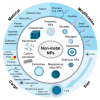Current Non-Metal Nanoparticle-Based Therapeutic Approaches for Glioblastoma Treatment
- PMID: 39200286
- PMCID: PMC11351974
- DOI: 10.3390/biomedicines12081822
Current Non-Metal Nanoparticle-Based Therapeutic Approaches for Glioblastoma Treatment
Abstract
The increase in the variety of nano-based tools offers new possibilities to approach the therapy of poorly treatable tumors, which includes glioblastoma multiforme (GBM; a primary brain tumor). The available nanocomplexes exhibit great potential as vehicles for the targeted delivery of anti-GBM compounds, including chemotherapeutics, nucleic acids, and inhibitors. The main advantages of nanoparticles (NPs) include improved drug stability, increased penetration of the blood-brain barrier, and better precision of tumor targeting. Importantly, alongside their drug-delivery ability, NPs may also present theranostic properties, including applications for targeted imaging or photothermal therapy of malignant brain cells. The available NPs can be classified into two categories according to their core, which can be metal or non-metal based. Among non-metal NPs, the most studied in regard to GBM treatment are exosomes, liposomes, cubosomes, polymeric NPs, micelles, dendrimers, nanogels, carbon nanotubes, and silica- and selenium-based NPs. They are characterized by satisfactory stability and biocompatibility, limited toxicity, and high accumulation in the targeted tumor tissue. Moreover, they can be easily functionalized for the improved delivery of their cargo to GBM cells. Therefore, the non-metal NPs discussed here, offer a promising approach to improving the treatment outcomes of aggressive GBM tumors.
Keywords: glioblastoma; non-metal nanoparticles; novel therapeutic strategies.
Conflict of interest statement
The authors declare no conflict of interest.
Figures



References
-
- Kanderi T., Munakomi S., Gupta V. StatPearls. StatPearls Publishing; Treasure Island, FL, USA: 2024. Glioblastoma Multiforme. - PubMed
Publication types
LinkOut - more resources
Full Text Sources

